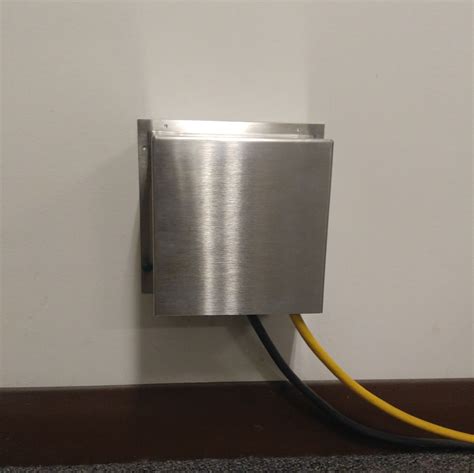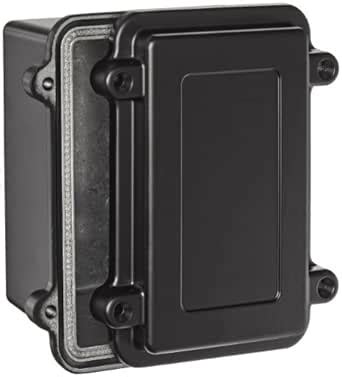electrical shielding box aluminum or steel These enclosures reduce electromagnetic interference (EMI) and radio frequency interference (RFI), which can cause electrical problems like flickering monitors, interrupted data signals, . Choosing the Right Electrical Box for Your Project. Selecting the appropriate electrical box depends on several factors, including construction, wiring method, devices, location, and safety. Type of Construction. Your project’s construction type influences the choice of .
0 · shielding electrical boxes
1 · rfi shielding electrical box
2 · emi shielding cables
3 · emi shielding boxes
4 · emi rfi shielding box
5 · electrical enclosure shield
6 · aluminum vs emi shielding
7 · aluminum emi shield
Here we describe matching 15-Amp receptacles to 15-Amp circuits, 20-Amp receptacles to 20-Amp circuits, two-wire receptacles where no ground is present, GFCI and AFCI electrical receptacles, and the proper electrical box to hold and mount these devices.
Aluminum is a good conductor of electricity and heat, which makes it an ideal choice for EMI/RFI shielding. It is lightweight and strong (it can withstand greater pressure than steel) but also inexpensive. Aluminum’s low density allows for thinner sheets with the same strength as .
Here are nine of the most widely used options for EMI shielding. 1. Beryllium copper — This option has electrical properties that provide EMI .
shielding electrical boxes
rfi shielding electrical box
These enclosures reduce electromagnetic interference (EMI) and radio frequency interference (RFI), which can cause electrical problems like flickering monitors, interrupted data signals, . Aluminum, copper, and steel are common materials for EMI shielding due to their excellent conductivity and ability to reflect or absorb electromagnetic waves. Plastic .About the 3 most popular metals used in EMI/RFI shielding: pre-tin plated steel, copper alloy 770/nickel sliver, copper and aluminum. Aluminum is lightweight, strong, and highly conductive, which makes it particularly useful for blocking a wide range of electronic waves. Of note, however, it is less effective than steel for protection against low-frequency .
Aluminum is a good conductor of electricity and heat, which makes it an ideal choice for EMI/RFI shielding. It is lightweight and strong (it can withstand greater pressure than steel) but also inexpensive. Aluminum’s low density allows for thinner sheets with the same strength as thicker sheets made from other metals. EMI shielding is the practice of using various countermeasures to protect electrical and electronic devices from EMI. Some common methods of EMI shielding include: Many electrical device designers will specify an electrical enclosure box made from a conductive metal like aluminum or steel due to these metals’ natural EMI protection. Here are nine of the most widely used options for EMI shielding. 1. Beryllium copper — This option has electrical properties that provide EMI shielding over a broad frequency range. Plus, beryllium copper's mechanical properties, including high tensile strength, offer a high deflection range and long lifespan.These enclosures reduce electromagnetic interference (EMI) and radio frequency interference (RFI), which can cause electrical problems like flickering monitors, interrupted data signals, and unwanted radio noise. Use them near motors, generators, and .
Aluminum, copper, and steel are common materials for EMI shielding due to their excellent conductivity and ability to reflect or absorb electromagnetic waves. Plastic enclosures with conductive coatings or metal meshes are also used, offering a lightweight and cost-effective solution for specific applications.About the 3 most popular metals used in EMI/RFI shielding: pre-tin plated steel, copper alloy 770/nickel sliver, copper and aluminum. Aluminum is lightweight, strong, and highly conductive, which makes it particularly useful for blocking a wide range of electronic waves. Of note, however, it is less effective than steel for protection against low-frequency electromagnetic radiation. Copper is by far the most popular EMI shielding material for radio and magnetic frequencies.
Choosing the right EMI shielding material is crucial for designing effective EMC solutions. Each material offers unique advantages and must be selected based on specific application requirements, including shielding effectiveness, mechanical properties, environmental resistance, and cost considerations.Nemaco has dedicated this basic technical section for each type of indoor & outdoor RF enclosure (with EMI shielding added to) NEMA 3, 3R enclosures, steel NEMA 4X enclosures (aluminum, stainless steel) and NEMA 6P enclosures (aluminum, stainless steel). Enclosures manufactured from a highly conductive material such as silver, aluminum, steel or copper are most ideal for EMI-RFI shielding, as they provide a natural barrier.
Aluminum is a good conductor of electricity and heat, which makes it an ideal choice for EMI/RFI shielding. It is lightweight and strong (it can withstand greater pressure than steel) but also inexpensive. Aluminum’s low density allows for thinner sheets with the same strength as thicker sheets made from other metals. EMI shielding is the practice of using various countermeasures to protect electrical and electronic devices from EMI. Some common methods of EMI shielding include: Many electrical device designers will specify an electrical enclosure box made from a conductive metal like aluminum or steel due to these metals’ natural EMI protection. Here are nine of the most widely used options for EMI shielding. 1. Beryllium copper — This option has electrical properties that provide EMI shielding over a broad frequency range. Plus, beryllium copper's mechanical properties, including high tensile strength, offer a high deflection range and long lifespan.These enclosures reduce electromagnetic interference (EMI) and radio frequency interference (RFI), which can cause electrical problems like flickering monitors, interrupted data signals, and unwanted radio noise. Use them near motors, generators, and .
emi shielding cables
Aluminum, copper, and steel are common materials for EMI shielding due to their excellent conductivity and ability to reflect or absorb electromagnetic waves. Plastic enclosures with conductive coatings or metal meshes are also used, offering a lightweight and cost-effective solution for specific applications.About the 3 most popular metals used in EMI/RFI shielding: pre-tin plated steel, copper alloy 770/nickel sliver, copper and aluminum. Aluminum is lightweight, strong, and highly conductive, which makes it particularly useful for blocking a wide range of electronic waves. Of note, however, it is less effective than steel for protection against low-frequency electromagnetic radiation. Copper is by far the most popular EMI shielding material for radio and magnetic frequencies.Choosing the right EMI shielding material is crucial for designing effective EMC solutions. Each material offers unique advantages and must be selected based on specific application requirements, including shielding effectiveness, mechanical properties, environmental resistance, and cost considerations.
Nemaco has dedicated this basic technical section for each type of indoor & outdoor RF enclosure (with EMI shielding added to) NEMA 3, 3R enclosures, steel NEMA 4X enclosures (aluminum, stainless steel) and NEMA 6P enclosures (aluminum, stainless steel).


emi shielding boxes

emi rfi shielding box
electrical enclosure shield
aluminum vs emi shielding
Metal epoxy paint will work, but will require recoating from time to time. Trick here is it has to completely dry before getting wet (4 hours is not enough for painting in place). .
electrical shielding box aluminum or steel|emi shielding boxes